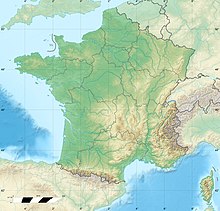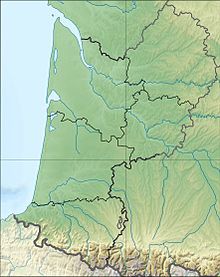
Back Lo Mostièr Catalan Le Moustier German Le Moustier Spanish Le Moustier Basque Le Moustier French Le Moustier Croatian Le Moustier Italian Le Moustier Dutch Lo Mostièr Occitan Le Moustier Polish
Le Moustier | |
 Le Moustier 1 in 1909, before WWII bombing. | |
| Location | Peyzac-le-Moustier |
|---|---|
| Region | Dordogne, France |
| Coordinates | 44°59′38″N 1°3′36″E / 44.99389°N 1.06000°E |
| Site notes | |
| Excavation dates | 1863 |
| Archaeologists | Henry Christy, Édouard Lartet. |
| Part of | Prehistoric Sites and Decorated Caves of the Vézère Valley |
| Criteria | Cultural: (i), (iii) |
| Reference | 85-014 |
| Inscription | 1979 (3rd Session) |
| Area | 0.227 ha (24,400 sq ft) |
Le Moustier is an archeological site consisting of two rock shelters in Peyzac-le-Moustier, a village in the Dordogne, France. It is known for a complete skeleton of the species Homo neanderthalensis that was discovered in 1908. The Mousterian tool culture is named after Le Moustier, which was first excavated from 1863 by the Englishman Henry Christy and the Frenchman Édouard Lartet. In 1979, Le Moustier was inscribed on the UNESCO World Heritage List along with other nearby archeological sites as part of the Prehistoric Sites and Decorated Caves of the Vézère Valley.[1]
- ^ "Prehistoric Sites and Decorated Caves of the Vézère Valley". UNESCO World Heritage Centre. United Nations Educational, Scientific, and Cultural Organization. Retrieved 9 October 2021.
© MMXXIII Rich X Search. We shall prevail. All rights reserved. Rich X Search


